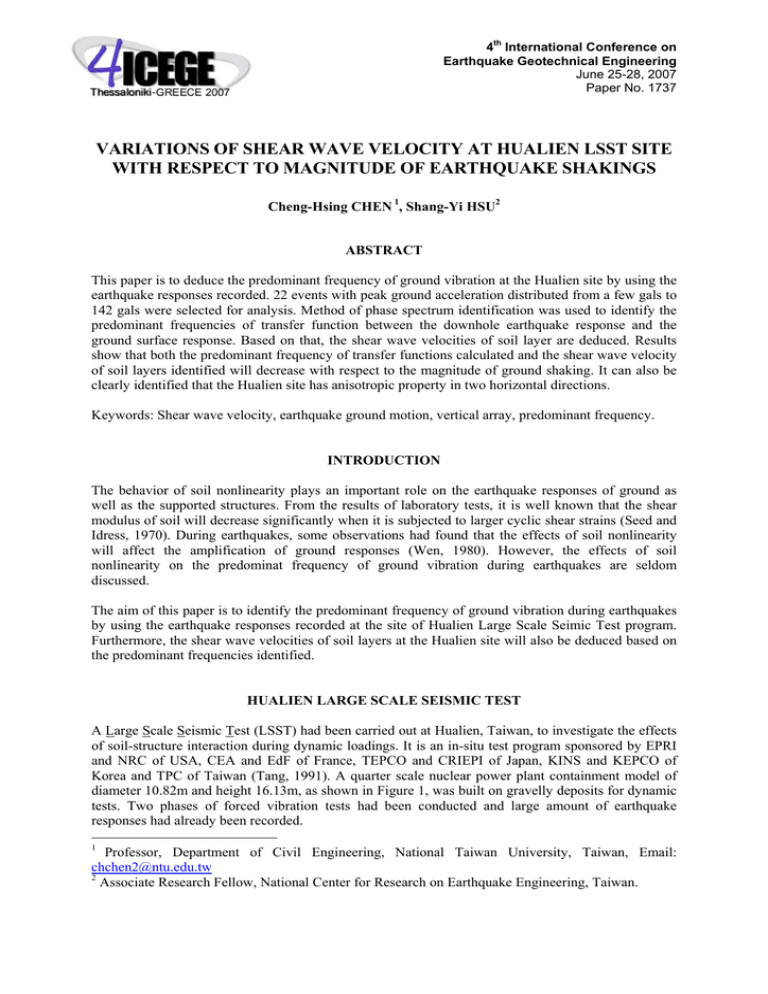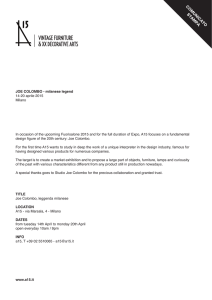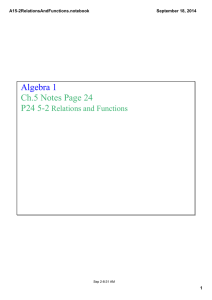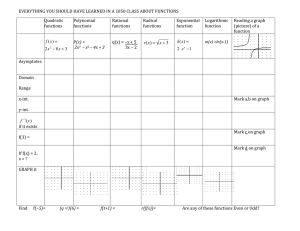VARIATIONS OF SHEAR WAVE VELOCITY AT HUALIEN LSST SITE
advertisement

4th International Conference on Earthquake Geotechnical Engineering June 25-28, 2007 Paper No. 1737 VARIATIONS OF SHEAR WAVE VELOCITY AT HUALIEN LSST SITE WITH RESPECT TO MAGNITUDE OF EARTHQUAKE SHAKINGS Cheng-Hsing CHEN 1, Shang-Yi HSU2 ABSTRACT This paper is to deduce the predominant frequency of ground vibration at the Hualien site by using the earthquake responses recorded. 22 events with peak ground acceleration distributed from a few gals to 142 gals were selected for analysis. Method of phase spectrum identification was used to identify the predominant frequencies of transfer function between the downhole earthquake response and the ground surface response. Based on that, the shear wave velocities of soil layer are deduced. Results show that both the predominant frequency of transfer functions calculated and the shear wave velocity of soil layers identified will decrease with respect to the magnitude of ground shaking. It can also be clearly identified that the Hualien site has anisotropic property in two horizontal directions. Keywords: Shear wave velocity, earthquake ground motion, vertical array, predominant frequency. INTRODUCTION The behavior of soil nonlinearity plays an important role on the earthquake responses of ground as well as the supported structures. From the results of laboratory tests, it is well known that the shear modulus of soil will decrease significantly when it is subjected to larger cyclic shear strains (Seed and Idress, 1970). During earthquakes, some observations had found that the effects of soil nonlinearity will affect the amplification of ground responses (Wen, 1980). However, the effects of soil nonlinearity on the predominat frequency of ground vibration during earthquakes are seldom discussed. The aim of this paper is to identify the predominant frequency of ground vibration during earthquakes by using the earthquake responses recorded at the site of Hualien Large Scale Seimic Test program. Furthermore, the shear wave velocities of soil layers at the Hualien site will also be deduced based on the predominant frequencies identified. HUALIEN LARGE SCALE SEISMIC TEST A Large Scale Seismic Test (LSST) had been carried out at Hualien, Taiwan, to investigate the effects of soil-structure interaction during dynamic loadings. It is an in-situ test program sponsored by EPRI and NRC of USA, CEA and EdF of France, TEPCO and CRIEPI of Japan, KINS and KEPCO of Korea and TPC of Taiwan (Tang, 1991). A quarter scale nuclear power plant containment model of diameter 10.82m and height 16.13m, as shown in Figure 1, was built on gravelly deposits for dynamic tests. Two phases of forced vibration tests had been conducted and large amount of earthquake responses had already been recorded. 1 Professor, Department of Civil Engineering, National Taiwan University, Taiwan, Email: chchen2@ntu.edu.tw 2 Associate Research Fellow, National Center for Research on Earthquake Engineering, Taiwan. Figure 1. The 1/4 containment model at Hualien LSST (a) Surface array (b) Downhole array Figure 2. Layout of strong motion arrays at Hualien LSST Layout of strong motion arrays In Hualien Project, an intense strong motion array had been installed around the model structure, as shown in Figure 2. There are three surface linear arrays (designated as ARM1, ARM2 and ARM3, respectively), and three vertical arrays located under the stations A15, A25 and A21 (designated as A15, A25 and A21 vertical arrays, respectively). In each vertical array, four downhole accelerometers were installed at the depths of 5.3 m, 15.8 m, 26.3 m and 52.6 m, respectively. Since A15 and A25 vertical arrays are located at a distance of 52.6 m from the center of the containment model, they can be regarded as free-field arrays. In subsequent analyses, the motions recorded at the A15 vertical array will be adopted for ground motion analysis. Strong ground motions selected Since the completion of the LSST arrays at Hualien, a total of 113 earthquakes with local magnitude larger than 4 had been recorded in the period 1993 to 2002. Among them, 22 events will be selected for this study. They are listed as shown in Table 1. Those earthquakes have local magnitudes distributed from 4.6 to 7.3, including the disastrous Chi-Chi earthquake occurred on Sept. 20, 1999 (Event 9). The peak ground accelerations recorded at the surface station A15 are also shown in Table 1. They are distributed from a few gals to 142 gals. Geological profile at the Hualien LSST site The Hualien LSST site is located on thick gravelly deposits, namely the Meilung gravel formation. The geological profile near the ground surface is shown in Figure 3 (CRIEPI, 1993). The top 5 meters are loosely deposited sands. Below that, the gravel formation is massive unconsolidated conglomerate composed of pebbles varying in diameter from 10cm to 20cm. The distribution of shear wave velocities obtained from geophysical surveys (P-S logging) is also shown in Figure 3. The velocities increase from 133 m/s at the ground surface to about 550m/s at a depth of 50m. Table 1. Earthquake data selected for analysis Lat. (N) LOCAL MAG. (ML) V EW NS 121 51.83 24 03.53 5.6 24.52 43.77 32.12 1994 06 05 01:09:27 121 51.24 24 27.36 6.2 28.33 27.82 41.39 3 1994 10 05 01:13:38 121 43.13 23 09.22 5.8 12.03 38.76 27.39 4 1995 02 23 05:18:54 121 41.13 24 12.13 5.8 30.05 39.27 48.82 5 1995 05 01 14:50:45 121 31.99 24 02.66 4.9 115.48 73.73 135.79 6 1995 05 02 06:17:21 121 38.04 24 00.74 4.6 118.26 64.92 87.11 7 1995 10 07 11:08:37 121 40.34 23 51.58 4.7 4.76 10.05 7.34 8 1996 05 28 21:53:13 121 34.58 24 03.12 5 86.30 51.49 80.63 9 1999 09 20 17:47:15 120 48.93 23 51.15 7.3 31.89 86.03 73.92 10 1999 09 20 18:11:52 121 03.37 23 51.05 6.7 23.86 31.75 59.52 11 1999 09 20 18:16:16 121 02.19 23 50.39 6.7 10.08 30.42 30.50 12 1999 09 20 20:43:48 121 19.48 23 45.58 6.5 8.36 13.41 16.59 13 1999 09 21 00:23:07 - - - 22.04 7.31 15.03 14 1999 09 22 00:14:39 121 02.56 23 50.17 6.8 15.06 33.72 47.87 15 1999 10 16 12:31:55 121 19.42 24 00.13 5 6.90 15.77 16.61 16 1999 10 22 03:10:43 120 25.50 23 31.58 6 2.60 5.91 5.23 17 1999 11 01 17:53:02 121 45.33 23 21.71 6.9 29.01 29.01 59.32 18 2000 05 06 13:41:57 121 30.00 24 02.40 5.0 106.00 47.88 71.73 19 2000 07 14 00:07:32 121 43.70 24 02.90 5.7 21.04 141.96 74.01 20 2000 09 10 08:54:46 121 35.03 24 05.12 6.2 99.77 56.94 103.96 21 2000 10 24 07:11:47 121 31.47 23 54.12 4.8 35.58 49.86 57.85 22 2002 03 31 06:52:57 122 11.29 24 08.23 6.8 16.28 54.27 44.50 LOCATION EQ No. ORIGIN TIME (UT) Lon. (E) 1 1994 01 20 05:50:17 2 PGA at A15 (gal.) Shear wave velocity (m/sec) 0 0 10 20 Depth (m) 30 40 50 60 70 Figure 3. Geological profile at Hualien LSST site 250 500 750 SPECTRAL ANALYSIS To investigate the characteristics of ground vibration, the earthquake data recorded from vertical arrays are very useful. The transfer function between the motions recorded at two depths can be used to identify the modal frequencies of vibration of soil layers through spectral analysis. Transfer functions Let the accelerogram recorded at certain depth be the i-series and the one on the ground surface be the 1-series. Through the applications of Fourier transforms, one can calculate the spectral ratio by H i1 ( f ) = H ii ( f ) H11 ( f ) (1) where H ii ( f ) and H11 ( f ) are the Fourier transforms of the i- and 1-series, respectively, and H i1 ( f ) is the transfer function between i- and 1-series. The transfer function H i1 ( f ) is a complex-valued function of frequency. Its absolute value defines the amplitude spectrum, and the arctangent value of the ratio between the imaginary and the real parts defines the phase spectrum. Both of them can be used to identify the modal frequencies of vibration for the soils in between. Usually, the amplitude spectrum is used to identify the modal frequencies. From the first valley of the amplitude spectrum, the predominant frequency can be determined. Furthermore, the predominant frequency can also be identified from the phase spectrum where the phase angle is equal to 900. Phase spectrum identification Theoretically, both the amplitude and phase spectra are continuous smooth function of frequency f. However, the real spectral ratios calculated from earthquake records are highly oscillated in general. In engineering applications, a lot of smoothing techniques have been proposed to smooth the amplitude function in order to identify where the predominant frequency is located. However, the amplitude function smoothed by averaging procedure is still wide-banded at most times and can not easily be used to determine the predominant frequency . In this paper, the technique of using phase spectrum to identify the lowest modal frequency will be used as an alternative method. The advantage of using this method is that the curve fitted to the phase spectrum will across the line of 900 with a very step slope so that the results of identification is not so sensitive to the method of curve fitting as in the case of using amplitude function. This method has been used by Chen and Chiu(1998). To illustrate the method of predominant frequency identification used in this study, the spectral analysis for the motions of A15 vertical array recorded in the Sept. 20, 1999 earthquake (Event 9) is shown below. Figures 4(a)~(d) are the phase spectra of the transfer functions of D11NS/A15NS, D12NS/A15NS, D13N8/A15NS and D14NS/A15NS, respectively. The frequency interval in those figures is very small (△f=0.0061Hz) so that the data points look rather scattered. However, they are distributed like a monotonic increasing function starting from about 00 towards 3600. Then, a polynomial of order 9 is used for curve fitting. From the fitted curve as shown in each figure, the frequency where the fitted curve across the line of 900 is the predominant frequency of associated soil layers. They are located at frequencies of 8.50Hz, 4.98Hz, 3.45Hz and 2.22 Hz, respectively. Predominant frequencies By using the same procedure, the predominant frequencies for all the earthquakes studies are identified as shown in Table 2. In each case, the frequency obtained can be recognized as the predominant frequency of soil layers between the ground surface and the depth when the designated downhole accelerometer located. Therefore, the thicker the soils are, the lower the modal frequency can be identified. It can also be observed from the results obtained, for the same earthquake, the predominant frequencies identified have lower values in the EW direction as compared to the results in the NS direction. D11/A15 225 PHASE FITTED 135 90 45 0 135 90 45 0 -45 -45 -90 -90 0 1 2 PHASE FITTED 180 Phase (degree) Phase (degree) 180 D12/A15 225 3 4 5 6 7 Frequency (Hz) 8 9 10 0 1 2 3 (a) D11/A15 9 10 D14/A15 225 PHASE FITTED PHASE FITTED 180 Phase (degree) 180 135 8 (b) D12/A15 D13/A15 225 Phase (degree) 4 5 6 7 Frequency (Hz) 90 45 0 -45 135 90 45 0 -45 -90 -90 0 1 2 3 4 5 6 7 Frequency (Hz) 8 9 0 10 1 2 (c) D13/A15 3 4 5 6 7 Frequency (Hz) 8 9 10 (d) D14/A15 Figure 4. Phase spectrum of transfer functions-NS component D11/A15 D12/A15 8.0 Predominant frequency (Hz) Predominant frequency (Hz) 16.0 EW NS 14.0 12.0 10.0 8.0 6.0 4.0 2.0 0.0 EW NS 7.0 6.0 5.0 4.0 3.0 2.0 1.0 0.0 0 25 50 75 100 A15 PGA (gal) 125 0 150 25 (a) D11/A15 50 125 150 (b) D12/A15 D13/A15 D14/A15 4.0 Predominant frequency (Hz) 8.0 Predominant frequency (Hz) 75 100 A15 PGA (gal) EW NS 7.0 6.0 5.0 4.0 3.0 2.0 1.0 0.0 EW NS 3.5 3.0 2.5 2.0 1.5 1.0 0.5 0.0 0 25 50 75 100 A15 PGA (gal) (c) D13/A15 125 150 0 25 50 75 100 A15 PGA (gal) (d) D14/A15 Figure 5. Predominant frequency of transfer functions vs. PGA at A15 125 150 Table 2. Predominant frequencies identified from transfer functions EQ No. 1 2 3 4 5 6 7 8 9 10 11 A15 PGA (gal.) 43.77 27.82 38.76 39.27 73.73 64.92 10.05 51.49 86.03 31.75 30.42 D11/A15 f21 9.74 10.40 9.72 8.71 9.48 9.39 11.08 8.57 7.30 6.76 8.54 D12/A15 f31 4.04 4.13 4.03 3.97 3.68 4.13 5.13 3.92 3.19 3.74 3.97 D13/A15 f41 2.88 2.94 2.87 2.75 2.74 2.86 3.45 3.34 2.19 2.80 2.94 D14/A15 f51 2.13 1.95 2.13 2.16 1.61 2.13 2.27 2.06 1.45 1.75 1.64 A15 PGA (gal.) 32.12 41.39 27.39 48.82 135.79 87.11 7.34 80.63 73.92 59.52 30.50 D11/A15 f21 10.80 11.56 11.09 10.63 9.12 9.83 11.65 9.39 8.50 8.86 10.18 D12/A15 f31 6.17 5.88 6.04 5.75 4.95 5.65 6.85 6.21 4.98 5.33 5.68 D13/A15 f41 4.46 4.55 4.60 3.79 3.58 4.01 4.70 4.13 3.45 3.54 3.91 D14/A15 f51 2.68 2.77 2.87 2.61 2.48 2.57 3.00 2.87 2.22 2.48 2.67 12 13 14 15 16 17 18 19 20 21 22 A15 PGA (gal.) 13.41 7.31 33.72 15.77 5.91 29.01 47.88 141.96 56.94 49.86 54.27 D11/A15 f21 7.40 10.50 7.08 9.63 10.52 8.63 6.76 6.32 7.50 7.47 9.62 D12/A15 f31 4.27 5.91 4.20 4.35 4.39 3.49 3.74 2.84 3.41 4.15 4.09 D13/A15 f41 3.20 3.34 2.78 3.47 3.52 2.22 2.80 1.81 2.64 2.88 2.66 D14/A15 f51 2.59 2.25 1.81 2.38 2.32 1.43 1.75 1.14 1.71 1.98 1.68 A15 PGA (gal.) 16.59 15.03 47.87 16.61 5.23 59.32 71.73 74.01 103.96 57.85 44.50 D11/A15 f21 11.23 11.65 10.02 11.10 13.99 9.84 8.86 8.54 6.96 8.59 11.01 D12/A15 f31 6.37 7.10 5.49 5.90 6.54 5.00 5.33 4.65 4.93 6.13 5.51 D13/A15 f41 4.30 4.74 3.82 4.41 4.74 3.53 3.54 3.52 3.52 4.06 3.93 D14/A15 f51 2.83 3.10 2.50 2.88 3.08 2.25 2.48 2.11 2.32 3.06 2.46 EW NS EQ No. EW NS Predominant frequency vs. PGA at A15 The earthquake events selected for analysis have different magnitude of ground shaking. The peak ground accelerations recorded at the surface station A15 are distributed from a few gals to 142 gals. When the predominant frequencies obtained are plotted with respect to the PGA recorded at A15 as shown in Figures 5(a)~(d), it can be clearly seen that the predominant frequency of vibration will decrease with the value of PGA at A15, i.e., with the magnitude of ground shaking. This is due to the effects of nonlinearity of soil when it is subjected to larger shear strains. It can also be observed from those figures, the predominant frequencies identified have lower values in the EW direction as compared to the results in the NS direction. It may be attributed from the effects of soil an-isotropic. The same results had been observed from the results of Forced vibrations performed on the containment of Hualien site (TEPCO, 1993; de Barros, 1995). IDENTIFICATION FOR SHEAR WAVE VELOCITY Four layer ground model In A15 vertical array, the downhole accelerometers are located at depths of 5.3 m, 15.8 m, 26.3 m and 52.6 m, respectively. From the results of geological explorations as shown in Figure 3, it is known that the LSST site has a quite simple geological profile, a sand layer of thickness 5 m overlying a very thick gravel formation. The shear wave velocities shown in this figure are the results measured from the geophysical survey (PS-logging). They are usually regarded as the small strain velocity. Based on that, it is reasonable to adopt a simple ground model, as shown in Figure 6, for wave velocity identification. From ground surface to the depth of 52.6 m, the ground is divided into 4 layers according to the depths of downhole accelerometers. Each layer has thickness hi and mass density ρi . The underlying soils are regarded as a half-space. The ground motions excited by earthquakes are rather complex in nature. However, for engineering applications, it is often assumed that the horizontal ground motions are mainly produced by vertically propagating SH waves, i.e., the 1-D shear beam model can be applied. By substituting the predominant frequencies identified previously into the characteristic equations of SH wave traveling in the associated soil layers, the shear wave velocity of each layer can then be identified subsequently. It is noted that the damping ratio of soil has very little effect on the modal frequency of ground. Therefore, it is convenient to assume that the damping ratios of soils are all equal to zero in deriving the characteristic equation of soil layers. This leads to a real-valued characteristic equation which is much easier for calculation purpose. Based on the theory of wave propagation, the characteristic equation of transfer function between different soil layer can be derived as follows. Single Layer Over a Half-Space For a single layer on top of an elastic half-space as shown in Figure 7(a), the transfer function can be written as ⎛ 2πf h1 ⎞ U2 ⎟⎟ = cos⎜⎜ U1 ⎝ C s1 ⎠ (2) Let f21 be the predominant frequency as identified from the transfer function between the first downhole station and the surface station, then the equivalent shear wave velocity for the first layer can be estimated by Cs1 = 4 f 21 h1 (3) Two Layer Over a Half-Space For a system of two layers of soil on top of an elastic half-space as shown in Figure 7(b), the transfer function can be written as ⎛ 2πfh1 ⎞ ⎛ 2πfh2 ⎞ ⎛ 2πfh1 ⎞ ⎛ 2πfh2 ⎞ U3 ⎟⎟ ⎟⎟sin⎜⎜ ⎟⎟ −ρ1Cs1sin⎜⎜ ⎟⎟cos⎜⎜ = ρ 2Cs 2 cos⎜⎜ U1 ⎝ Cs1 ⎠ ⎝ Cs 2 ⎠ ⎝ Cs1 ⎠ ⎝ Cs 2 ⎠ (4) The characteristic equation corresponding to the predominant frequency f31 is ⎛ 2π f 31 h1 ⎞ ⎛ 2π f 31 h2 ⎞ ρ 2Cs 2 ⎟⎟ = ⎟⎟tan ⎜⎜ tan ⎜⎜ ⎝ Cs1 ⎠ ⎝ Cs 2 ⎠ ρ1Cs1 Given f31 from Table 2 and Cs1 from previous model, Cs2 is the first positive root of Eq.(5). (5) Multi-Layer System For the system of 3 soil layers on top of an elastic half-space as shown in Figure 7(c), the upper two layers can be regarded as an equivalent uniform single layer of thickness h1 and velocity Cs1 where h1 = h1 + h2 Cs1 = 4h1 f 13. (6) (7) Now regard the upper three layers of soil as two layers of soil with thicknesses h1 and h3 and shear wave velocities Cs1 and Cs3, respectively, as shown in Figure 7(d). Then Cs3 can now be solved based on Eq.(5) when the predominant frequency f41 is given from Table 2. For a system having more layers of soil, the same procedure can be used recursively to calculate the shear wave velocity for each layer. Figure 6. Ground model used for system identification (a) Single layer model (c) Three layers model (b) Two layer model (d) Equivalent two layer to system (c) Figure 7. Idealized model for calculation of shear wave velocity Table 3. Shear wave velocities for each layer identified EW NS EW NS EQ No. 1 2 3 4 5 6 7 8 9 10 11 Layer Cs (m/s) Cs (m/s) Cs (m/s) Cs (m/s) Cs (m/s) Cs (m/s) Cs (m/s) Cs (m/s) Cs (m/s) Cs (m/s) Cs (m/s) L1 195 221 206 185 201 199 235 182 155 143 181 L2 263 246 241 240 219 248 310 245 198 241 249 L3 296 329 323 302 321 315 372 441 221 302 315 L4 426 448 527 573 348 530 516 436 316 371 333 L1 224 245 235 225 193 208 247 199 180 188 216 L2 394 361 357 356 307 355 433 426 324 353 368 L3 451 556 549 403 408 449 514 407 350 349 394 L4 533 606 645 610 583 577 672 647 478 561 596 EQ No. 12 13 14 15 16 17 18 19 20 21 22 Layer Cs (m/s) Cs (m/s) Cs (m/s) Cs (m/s) Cs (m/s) Cs (m/s) Cs (m/s) Cs (m/s) Cs (m/s) Cs (m/s) Cs (m/s) L1 157 223 150 204 223 183 143 134 159 158 204 L2 279 384 277 271 271 215 241 178 213 268 254 L3 346 307 274 405 411 214 302 174 296 292 259 L4 680 495 391 532 504 308 371 242 370 440 360 L1 238 247 212 235 296 209 188 181 148 182 233 L2 415 472 354 378 409 317 353 300 351 436 349 L3 428 468 388 476 495 364 349 384 364 400 407 L4 618 674 544 626 664 481 561 442 506 735 523 Shear wave velocities identified Based on the procedure described above and the predominant frequencies shown in Table 2, the shear wave velocities for Layer L1(0~5.3m), Layer L2(5.3~15.8m), Layer L3(15.8~26.3m), and Layer L4(26.3~52.6m) can be calculated layer by layer. For all cases, the velocity profile identified from the NS and EW ground responses are summarized in Table 3. It shows that the velocities identified from the EW responses are smaller than those from the NS responses in general. It is as expected because the predominant frequencies obtained from spectral analyses have lower values in EW direction. Gunturi et al.(1998) had used the data of two earthquakes (Events 4 and 5 of this paper) to identify the shear wave velocities of soils by method of cross-correlation function, and similar results to this study were obtained except for the deepest layer. Shear wave velocity vs. magnitude of ground shaking To correlate the shear wave velocities with the magnitude of ground shaking, the shear wave velocities identified in Table 3 are plotted with respect to the PGA recorded at the depth of the top of each layer, as shown in Figures 8(a)~(d). It can be clearly seen that the shear wave velocity of each layer is decreased with the value of PGA recorded at the top of each layer, i.e., with the magnitude of ground shaking. This is due to the effect of nonlinearity of soil when it is subjected to larger shear strains. It can also be observed from those figures, the shear wave velocities identified have lower values in the EW direction as compared to the results in the NS direction. It is attributed from the effects of soil anisotropy. The same trend had been obtained from previous study (Hsu and Chen, 2003). CONCLUSIONS Based on the results obtained, some conclusions can be deduced as follows: 1. The method of phase spectrum identification is very effective to deduce the predominant frequency of vibration of soils by using the transfer function of earthquake responses recorded. 2. The predominant frequency of transfer function between the downhole earthquake response and the ground surface response will decrease with respect to the value of PGA at the ground surface. This is due to the effects of soil nonlinearity when the ground is subjected to larger excitations. 3. For the Hualien site, the shear wave velocity of each layer identified from the earthquake responses is decreased with respect to the value of PGA recorded at the top of each layer. 4. Both the predominant frequency of transfer functions calculated and the shear wave velocity of soil layers identified from earthquake responses show that the ground of Hualien site is anisotropic in two horizontal directions. A15~D11 (0m ~ 5.3m) D11~ D12 (5.3m ~ 15.8m) 600 300 EW 250 NS EW 500 NS Cs (m/s) Cs (m/s) 350 200 150 400 300 200 100 100 50 0 0 0 20 40 60 80 A15 PGA(gal.) 100 120 140 0 20 40 (a) A15~D11 60 80 D11 PGA(gal.) 100 140 (b) D11~D12 D12~ D13 (15.8m ~ 26.3m) D13~ D14 (26.3m ~ 52.6m) 600 900 EW 500 EW 750 NS NS 400 Cs (m/s) Cs (m/s) 120 300 600 450 200 300 100 150 0 0 0 20 40 60 D12 PGA(gal.) 80 100 0 (c) D13~D14 20 40 D13 PGA(gal.) 60 80 (d) D14~D15 Figure 8. Shear wave velocity vs. PGA at the top of each layer AKNOWLEDGEMENTS Earthquake data provided by the Taipower company and financial support by the National Science Council of Taiwan (NSC – 90 - 2811 – E - 002 – 034) are deeply appreciated. REFERENCES Chen CH and Chiu HC. “Anisotropic seismic ground responses identified from the Hualien vertical array”, Soil Dynamics and Earthquake Engineering, Vol 17, 371-395, 1998. Chen CH and Chiu HC. “Identification of shear wave velocity from earthquake ground motions”, Proc., 2nd Inter. Conf. Earthq. Geotech. Engrg., Lisbon, Portugal, 1:205-210, 1999. Central Research institute of Electric Power industry (CRIEPI). “Soil Investigation Report for Hualien Project”, Report, 1993. de Barros, FCP and Luco JE. “Identification of foundation impedance functions and soil properties from vibration tests of the Hualien containment model”, Soil Dyn. Earthq. Engrg., 14:229-248, 1995. Gunturi VR., Elgamal, AW and Tang HT. “Hualien seismic downhole data analysis”, Engrg. Geol.. 50(1-2):9-29, 1998. Hsu SY and Chen CH. “Anisotropic Ground Response of the Hualien Containment Model,” Proc. of the Sixteenth KKCNN Symposium on Civil Engineering, Gyeongiu, Korea, 2003. Pires JA and Higgins CJ. “Soil-structure interaction in cross-anisotropic site conditions”, Geotech. Special Pub., ASCE, Reston, Virginia, 2:1271-1282, 1998. Seed HB and Idriss IM. “Shear Moduli and Damping Factors for Dynamic Response Analysis”, Report No. EERC-70/10, University of California, Berkeley, California, 1970. Tang HT., et al. “The Hualien Large Scale Seismic Test for Soil-Structure Interaction Research”, Transactions of the 11th SMiRT, Tokyo, Japan, K04/4, 1991. Tokyo Electric Power Co. (TEPCO). “Hualien LSST Project, Status Report of the forced Vibration Test Results, (Before Backfill) , (After Backfill) ”, Report, 1993.





